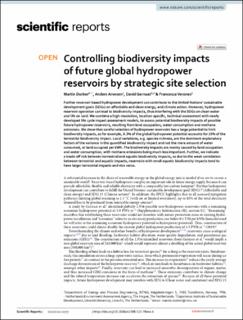| dc.contributor.author | Dorber, Martin | |
| dc.contributor.author | Arvesen, Anders | |
| dc.contributor.author | Gernaat, David | |
| dc.contributor.author | Verones, Francesca | |
| dc.date.accessioned | 2021-09-14T07:45:23Z | |
| dc.date.available | 2021-09-14T07:45:23Z | |
| dc.date.created | 2020-12-16T11:26:34Z | |
| dc.date.issued | 2020 | |
| dc.identifier.citation | Scientific Reports. 2020, 10, . | en_US |
| dc.identifier.issn | 2045-2322 | |
| dc.identifier.uri | https://hdl.handle.net/11250/2776361 | |
| dc.description.abstract | Further reservoir-based hydropower development can contribute to the United Nations’ sustainable development goals (SDGs) on affordable and clean energy, and climate action. However, hydropower reservoir operation can lead to biodiversity impacts, thus interfering with the SDGs on clean water and life on land. We combine a high-resolution, location-specific, technical assessment with newly developed life cycle impact assessment models, to assess potential biodiversity impacts of possible future hydropower reservoirs, resulting from land occupation, water consumption and methane emissions. We show that careful selection of hydropower reservoirs has a large potential to limit biodiversity impacts, as for example, 0.3% of the global hydropower potential accounts for 25% of the terrestrial biodiversity impact. Local variations, e.g. species richness, are the dominant explanatory factors of the variance in the quantified biodiversity impact and not the mere amount of water consumed, or land occupied per kWh. The biodiversity impacts are mainly caused by land occupation and water consumption, with methane emissions being much less important. Further, we indicate a trade-off risk between terrestrial and aquatic biodiversity impacts, as due to the weak correlation between terrestrial and aquatic impacts, reservoirs with small aquatic biodiversity impacts tend to have larger terrestrial impacts and vice versa. | en_US |
| dc.language.iso | eng | en_US |
| dc.publisher | Springer Nature | en_US |
| dc.rights | Navngivelse 4.0 Internasjonal | * |
| dc.rights.uri | http://creativecommons.org/licenses/by/4.0/deed.no | * |
| dc.title | Controlling biodiversity impacts of future global hydropower reservoirs by strategic site selection | en_US |
| dc.type | Peer reviewed | en_US |
| dc.type | Journal article | en_US |
| dc.description.version | publishedVersion | en_US |
| dc.source.pagenumber | 13 | en_US |
| dc.source.volume | 10 | en_US |
| dc.source.journal | Scientific Reports | en_US |
| dc.identifier.doi | 10.1038/s41598-020-78444-6 | |
| dc.identifier.cristin | 1860459 | |
| dc.description.localcode | This article is licensed under a Creative Commons Attribution 4.0 International License, which permits use, sharing, adaptation, distribution and reproduction in any medium or format, as long as you give appropriate credit to the original author(s) and the source, provide a link to the Creative Commons licence, and indicate if changes were made. The images or other third party material in this article are included in the article's Creative Commons licence, unless indicated otherwise in a credit line to the material. If material is not included in the article's Creative Commons licence and your intended use is not permitted by statutory regulation or exceeds the permitted use, you will need to obtain permission directly from the copyright holder. To view a copy of this licence, visit http://creativecommons.org/licenses/by/4.0/. | en_US |
| dc.source.articlenumber | 21777 | en_US |
| cristin.ispublished | true | |
| cristin.fulltext | original | |
| cristin.qualitycode | 1 | |

